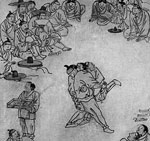Taekwondo 태권도Taekwondo Preschool
Korean martial arts are military practices and methods which have their place in the history of Korea but have been adapted for use by both military and non-military personnel as a method of personal growth or recreation.
About Hankumdo 한검도
Korean martial arts are military practices and methods which have their place in the history of Korea but have been adapted for use by both military and non-military personnel as a method of personal growth or recreation.
Hankumdo is a Korean sword-art where the basic techniques are based on the letters of the Korean alphabet, Hangul.
Goal
The goal of hankumdo is to teach people how to defend themselves and at the same time offer them exercises to stay healthy. It also is meant to give practitioners the means to come to a deeper understanding of martial arts principles. It aims to make this easy by using the Korean writing system to systematize the techniques.
History
Hankumdo was developed by Myung Jae Nam, who first taught his sword techniques as a separate art in 1986 and was first publicized in 1997 during the 3rd International H.K.D Games. Hankumdo originated from the techniques used in Hankido to defend against sword attacks. Though first presented as a subset of the larger Hankido curriculum under the name hankumdobub (hankumdo techniques), Myung Jae Nam later decided that it was an art that could stand on its own merits and is often taught as a separate discipline.
Hankumdo doesn't have clear roots in other sword arts, since Myung Jae Nam never received any formal education in other sword arts. The subset of techniques is quite limited, and consists only of the basics strikes and blocks found in most sword arts. GM Myung is thought to have organized his sword art, HanKumdo, around the calligraphy of the Korean Hangul alphabet. Though the techniques of the Hankumdo system of sword can be roughly divided into either offense or defensive, it is professed that using the 5 basic striking techniques one can write the entire Korean alphabet as a series of fencing combinations.
Meaning
The word hankumdo actually consists of three different words:
- Han (한 / 韓): Korea, Korean culture and mentality
- Kum (검 / 劍): Sword
- Do (도 / 道): The way
Hankumdo can be interpreted as: "The way for the Korean people to learn how to handle the sword"
Style
A number of modern Korean martial arts have been influenced by Japanese styles in the 20th century, while the older arts were influenced by the Chinese, which becomes obvious in the Muyedobotongji. Myung Jae Nam however wanted to create a true Korean sword art without any foreign influences. Japanese sword arts developed into the art of man-to-man duelling during the peaceful Edo period and are characterized by a lot of attention to detail under the influence of Zen Buddhism. Traditional Korean arts never underwent this change and were purely taught to soldiers as a way to fight on the battlefield, although this does not mean that in Japanese arts battlefield techniques are not taught. Battlefield fighting is usually characterized by more flowing and on-going movements. In duel-style fighting a lot of attention is given to the one-strike-one-kill principle, whereas in battlefield-style fighting the emphasis is on keeping the sword in motion and always being ready for the next strike.
To give hankumdo a true Korean edge, master Myung Jae Nam used the Korean alphabet, known as Hangul, to teach the basic strikes of the art.
Techniques
The basis for all Hankumdo techniques comes from the letters of the Korean alphabet, Hangul. This alphabet consists of 24 characters, 14 consonants (자음) and 10 vowels (모음). Since 1997 there have been several revisions of the techniques. In the earliest version the sword techniques reflected the manner in which one would write the characters on paper, thus requiring mastery of only four techniques. In the latest revision more techniques were added and the techniques become more elaborate. As a result, the manner of using the sword and of writing the letters may vary.
The strikes are being taught from several positions and with several steps, called Gi Bo Haeng (기보행). The techniques have the same name as the characters followed by the word Begi (베기) which means strike. So the name for the first technique is: Giyeokbegi (기역베기), because the name for the first character (ㄱ) in the Korean alphabet is Giyeok (기역).
Master Myung intended to develop a sword-art that would be truly Korean and easy to learn by everyone. For Koreans who already know the Korean writing system, the techniques are easy to remember, as the sword methods follow the standard manner in which the Korean characters are written. Foreigners are advised to learn how to write Hangul before starting with the sword techniques. Because the Korean writing system is fairly easy to learn, foreigners can become facile in the sword basics within a short period of time.
Development
After Myung Jae Nam's death in 1999, the development of hankumdo is overseen by the Jaenam Musul Won Foundation.
Quite a few changes and additions to the hankumdo curriculum have been made by Ko Ju Sik (고주식), the new technical director of the federation, since then.
There are five tenets defined in the International Taekwondo Federation (ITF) and several more in World Taekwondo (WT).
Integrity ( 염치 yeom-chi ): "Although it may be similar, this form of integrity takes on a more wider role then defined in the common dictionary. In taekwondo, integrity means not only to determine what is right or wrong but also having the conscience to feel guilt if one has done wrong and to have the integrity stand up for what is right." View Taekwondo Tenets »
RESOURCES
This article uses material from the Wikipedia article "Hankumdo", which is released under the Creative Commons Attribution-Share-Alike License 3.0.













